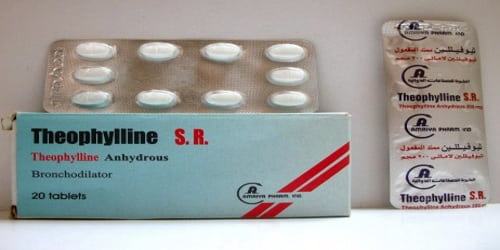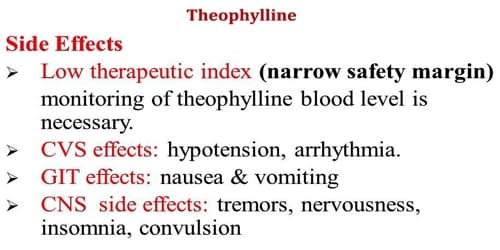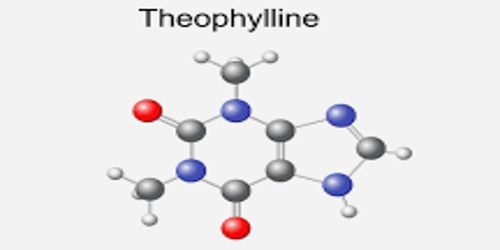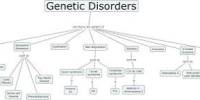Theophylline
Definition: Theophylline, also known as 1,3-dimethylxanthine, is used together with other medicines to treat the symptoms of asthma, bronchitis, emphysema, and other lung diseases. It belongs to a group of medicines known as bronchodilators.
As a member of the xanthine family, it bears structural and pharmacological similarity to theobromine and caffeine, and is readily found in nature, and is present in tea (Camellia sinensis) and cocoa (Theobroma cacao). A small amount of theophylline is one of the products of caffeine metabolic processing in the liver.
This drug comes in the form of an oral tablet, oral capsule, or an oral solution. People take these drugs by mouth. This medicine is available only with the doctor’s prescription.
Commonly Used Brand Name(s) – Elixophyllin, Norphyl, Phyllocontin, Quibron-T, Quibron-T/SR, Theo-24, TheoCap, Theochron, Theo-Dur, Theo-Time, Truxophyllin, Uniphyl
Do not take theophylline in larger or smaller amounts or for longer than recommended. Theophylline overdose can occur if people accidentally take too much at one time, or if their daily doses are too high. To be sure they are using the correct dose; their blood will need to be tested often.
Theophylline is naturally found in cocoa beans. Amounts as high as 3.7 mg/g have been reported in Criollo cocoa beans.
Trace amounts of theophylline are also found in brewed tea, although brewed tea provides only about 1 mg/L, which is significantly less than a therapeutic dose. Trace amounts of theophylline are also found in guarana (Paullinia cupana) and in kola nuts cola (plant).

Uses of Theophylline: Theophylline is used to treat the symptoms of asthma or other lung conditions that block your airways, such as emphysema or chronic bronchitis. It may be used as part of a combination therapy. This means people may need to take it with other medications.
The main actions of theophylline involve:
- relaxing bronchial smooth muscle
- increasing heart muscle contractility and efficiency; as a positive inotrope
- increasing heart rate: (positive chronotropic)
- increasing blood pressure
- increasing renal blood flow
- anti-inflammatory effects
- central nervous system stimulatory effect mainly on the medullary respiratory center.
The main therapeutic uses of theophylline are aimed at:
- chronic obstructive pulmonary disease (COPD)
- asthma
- infant apnea
Blocks the action of adenosine; an inhibitory neurotransmitter that induces sleep contracts the smooth muscles and relaxes the cardiac muscle.
Take this medicine exactly as directed by the doctor. Do not take more of it and do not take it more often than the doctor ordered. To keep the blood level constant, take this medicine at the same time each day and do not miss any doses.
Take the extended-release capsule or tablet every morning at the same time each day. People may take their second dose 10 to 12 hours after the morning dose and before the evening meal unless their doctor tells them otherwise.
Swallow the extended-release tablet whole. Do not break, crush, or chew it. People may take the extended-release tablet with or without food. It is best to take the extended-release capsule one hour before a high-fat meal or without food.
Theophylline works by opening the airways in our lungs. It does this by relaxing the muscles and decreasing the response to substances that cause our airways to constrict. This makes it easier for us to breathe.

Side Effects of Theophylline: The use of theophylline is complicated by its interaction with various drugs and by the fact that it has a narrow therapeutic window. Its use must be monitored by direct measurement of serum theophylline levels to avoid toxicity. Some of the more common side effects that can occur with use of theophylline include:
- A headache
- Sweating
- Trouble sleeping
- Stomach pain, diarrhea, and upset stomach
- Feeling restless, nervous, or irritable
Serious side effects and their symptoms can include the following:
- Severe or continued vomiting;
- Rapid or uneven heartbeats;
- Seizure (convulsions);
- Confusion, tremors or shaking;
- Nausea and vomiting, severe headache, rapid heart rate;
- Low potassium (confusion, uneven heart rate, extreme thirst, increased urination, leg discomfort, muscle weakness or limp feeling); or
- High blood sugar (increased thirst, increased urination, hunger, dry mouth, fruity breath odor, drowsiness, dry skin, blurred vision, and weight loss).
Theophylline toxicity can be treated with beta blockers. It should not be used in combination with SSRI Fluvoxamine.
Sometimes it is not safe to use certain drugs at the same time. Some medicines can affect how theophylline works, which could make it less effective or cause side effects. Theophylline could also affect how other medicines work, making them less effective or causing side effects.
Theophylline, despite its adverse effects and narrow therapeutic range, as discussed above, is still a potent bronchodilator. Current research regarding theophylline-based therapies is oriented towards employing theophylline, as well as other methylxanthines as natural scaffolding for new bronchodilatory pharmaceuticals.
Information Source:
















